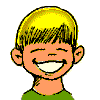Child, Variant (3.5e Template)
Child (Variant)
The knight errant's young squire, the child pupil of a wizard or druid, the prepubescent savage. Despite their difference of life style, they all have one thing in common. 3e Summary::They are all young and inexperienced, and usually runs quite a few years short of adulthood. This template allows you to create a child character fairly easily. For information of how children with a character class are interpreted, please view the Children and Class Features section.
Creating a Child
Most truly, the child template is neither acquired nor inherited. The template serves to tone down the base creature's strengths to a level more natural to that of a relatively inexperienced child. The best way of describing this template is as a way to create a character of level 0.
Size and Type
For all intents and purposes and regardless of the child's actual size, it is one size category smaller than its normal counterpart. Its type remains the same, although it also gains a 'Child' subtype.
Hit Dice
The actual Hit Dice of a child is half that of the base creature. For base creatures with only one Hit Die, the child gains a fractional ½ HD. This applies to all all HD gained through templates, HD gained through normal levels accrue as normal.
Note: A child of a base creature with only 1 HD that takes up a class with good base attack progression, like a fighter, still has a BAB of +0, since it possesses half a Hit Die and is, technically, 'level 0'. This again is prior to class selection.
Speed
A child's base land speed is in accordance to its new size category, excluding certain effects due to class.
Example: A human child will have a base land speed of 20 ft., but a human barbarian's child will have a base land speed of 30 ft.
Armor Class
The child gains a bonus (or loses a penalty) to AC in accordance to its smaller size. If the base creature has an innate natural armor bonus, it is halved and round down. The same goes for other such bonuses to AC, if applicable.
Example: A human child will have a +1 size bonus to AC. A troll child will have only a +2 natural armor bonus to AC.
Attack
The child retains his ability to use manufactured weapons, although they wield weapons corresponding to their size. They also retain any natural weapons of the base creature, their damage decreasing one step as per size. They gain a size bonus or lose a size penalty to attack.
Example: A human child wields a normal longsword two-handed, and can no longer use longbows or greataxes. A human monk child's unarmed strike will deal 1d4 damage instead of 1d6 damage.
Special Attacks
The child retains all special attacks of the base creature. Special attacks that deal physical damage change according to size category, whereas damage from magical special attacks decreases one die step (d6's become d4's, etc.). The DC of any special attack decreases due to the loss of HD. The range and duration of all of a child's special attacks halves.
Example: A troll child's Rend extraordinary ability deals a base damage of 2d4 instead of 2d6.
Special Qualities
The child retains all special qualities of the base creature. Special qualities like spell resistance, resistances, damage reduction, fast healing, regeneration have their quantities halved (round down). The range of sensory special qualities such as blindsight and darkvision halve as well.
Example: A troll child has regeneration 2 instead of 5 and darkvision out to 30 ft. instead of out to 60 ft.
Saves
A child gains saves from templates in accordance with his Hit Dice. For children with ½ HD, good saves have a +1 base save bonus and average saves have a +0 base save bonus.
Example: A human child fighter has the following base save bonuses: Fort +1, Ref +0, Will +0.
Abilities
-2 Strength, +4 Dexterity, -2 Intelligence, -2 Wisdom and +2 Charisma.
Skills
A child with 1 or more racial Hit Dice gains skill points normally, although if such a child has taken up a class, the last Hit Die of racial skill points is replaced by the skill points of the class level.
Example: A human child fighter with Int 10 has a total of 3×2 = 6 skill points available. When this child reaches adulthood, he will have Int 12 and a total of 4×4 = 16 skill points.
Feats
A child gains a number of character feats according to its HD to a minimum of 1 (even with ½ HD). A child does not normally gain bonus feats due to class, and gains only racial bonus feats. For this purpose, a human's extra bonus feat at 1st level does not count as racial. Only the first feat may be a background feat.
Example: A human child has only one feat. He does not gain the extra bonus feat due to his being human. A troll child however has 3 racial Hit Dice, and therefore two feats.
Environment
Any.
Organization
Any.
Challenge Rating
Half that of the base creature
Alignment
Same as base creature.
Advancement
By character class. A child that 'levels' becomes a 1st level character (whether it is by gaining adulthood or simply becoming sufficiently trained or schooled).


